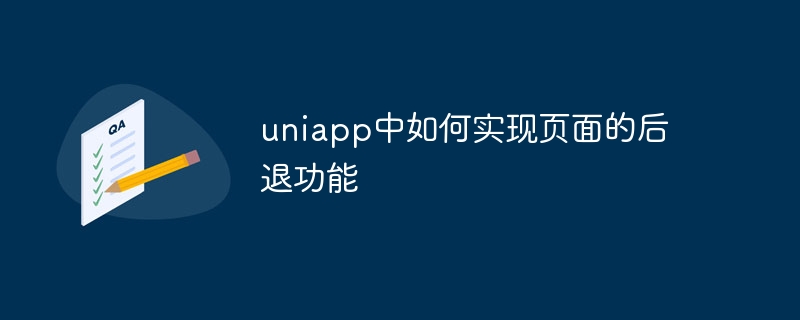How to implement the page back function in uniapp

Uniapp is a front-end framework for developing multi-platform applications. It is based on Vue.js and can compile the developed code into small programs, apps, H5 and other types of applications. Platform applications. In Uniapp, it is very simple to implement the page back function. This article will introduce how to implement the page back function in Uniapp and provide corresponding code examples.
To implement the back function of the page, we need to use the built-in methods and components provided by uni-app to operate. The specific steps are as follows:
- In the page file of uni-app, the
uni.navigateBack()method needs to be introduced. This method is used to return to the previous page.
<template>
<view>
<!-- 页面内容 -->
</view>
</template>
<script>
export default {
methods: {
navigateBack() {
uni.navigateBack()
}
}
}
</script>- When you need to trigger the back function, such as when clicking a button, you can call the
navigateBack()method to realize the page back.
<template>
<view>
<button @click="navigateBack">返回</button>
</view>
</template>
<script>
export default {
methods: {
navigateBack() {
uni.navigateBack()
}
}
}
</script>In the above code, we call the navigateBack() method in the button click event to realize the page back.
In addition to using the uni.navigateBack() method to implement the page's retreat, Uniapp also provides some other methods and components to control the page's retreat behavior.
-
uni.navigateBack(): Return to the previous page, equivalent to the browser's back function. - `uni.navigateBack({
delta: 2
}): Return to the previous two pages, you can set the value ofdelta` as needed. -
<navigator open-type="navigateBack">Return</navigator>: Use the<navigator></navigator>component to implement a back button-like function.
To summarize, it is very simple to implement the back function of the page in Uniapp. We only need to use the uni.navigateBack() method and the corresponding trigger event to achieve it. Of course, we can also choose to use the <navigator></navigator> component to implement the back button function. No matter which method is used, it is easy to rewind the page. I hope the code examples provided in this article can help you implement the page back function in Uniapp.
The above is the detailed content of How to implement the page back function in uniapp. For more information, please follow other related articles on the PHP Chinese website!

Hot AI Tools

Undresser.AI Undress
AI-powered app for creating realistic nude photos

AI Clothes Remover
Online AI tool for removing clothes from photos.

Undress AI Tool
Undress images for free

Clothoff.io
AI clothes remover

Video Face Swap
Swap faces in any video effortlessly with our completely free AI face swap tool!

Hot Article

Hot Tools

Notepad++7.3.1
Easy-to-use and free code editor

SublimeText3 Chinese version
Chinese version, very easy to use

Zend Studio 13.0.1
Powerful PHP integrated development environment

Dreamweaver CS6
Visual web development tools

SublimeText3 Mac version
God-level code editing software (SublimeText3)





